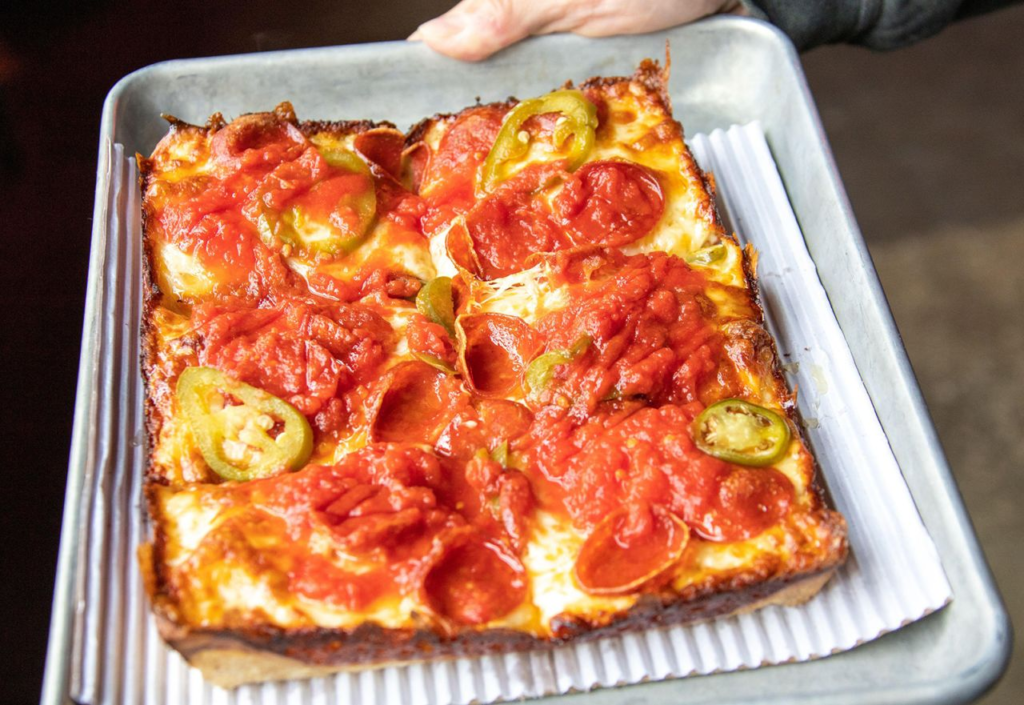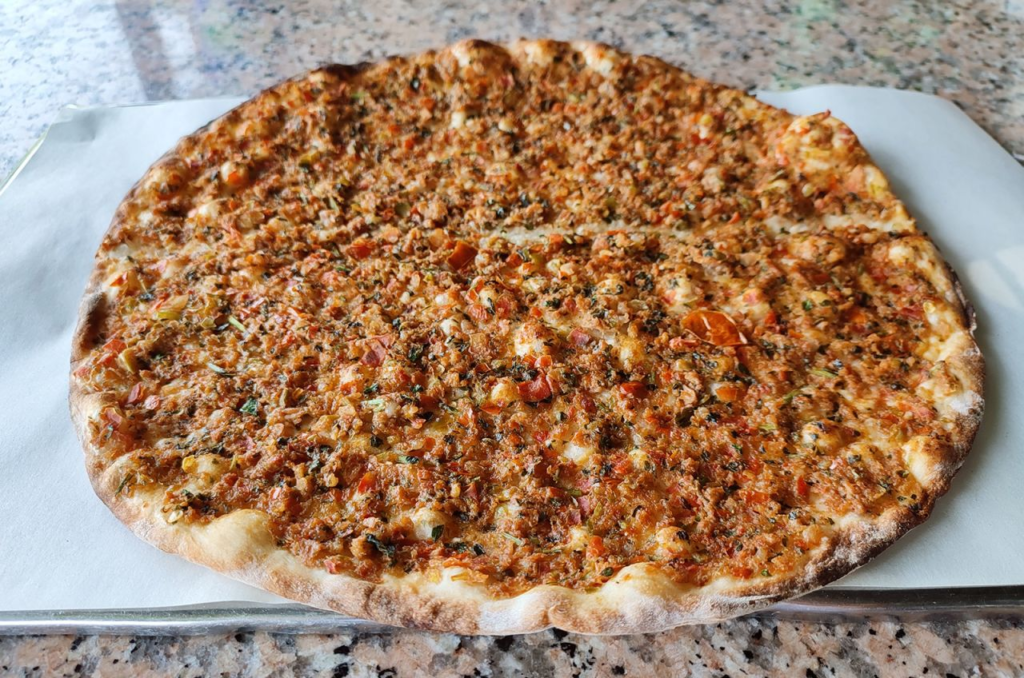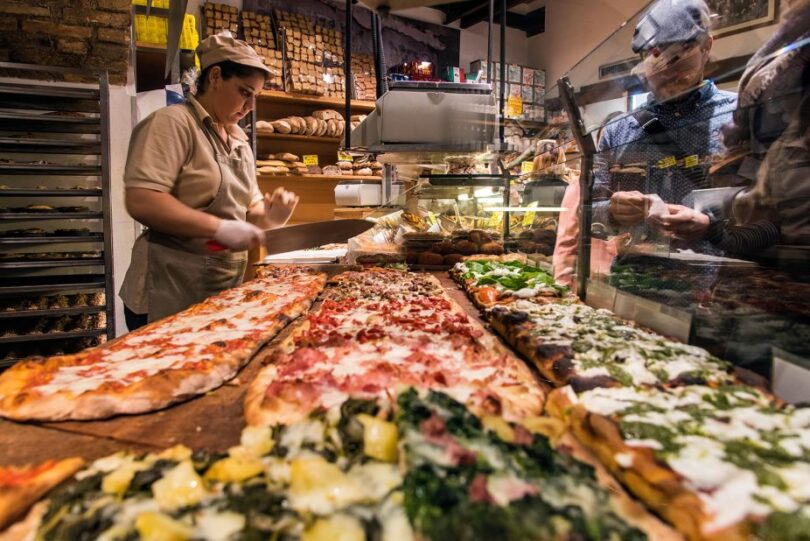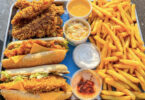(CNN): Is there any food more globally glorified than pizza?
The ultimate comfort food that traces its roots to Naples, Italy, has been adapted by cultures all over the world. Italians have even devised a series of lists of the best pizzas outside of Italy.
And it’s precisely pizza’s versatility that makes it so universally beloved, says Fabio Errante, an Italian ??pizzaiolo (pizza maker) and author of “Fabioulous Pizza.” Errante says he’s cooked more than 300,000 pizzas in his lifetime
“Pizza easily lends itself to extreme customization and fusion with other cultures and cuisines, and this explains why you will find a ‘pizzeria’ in every corner of the world,” he wrote in an email to CNN Travel.
Nino Coniglio, a ??pizzaiolo and owner of Brooklyn Pizza Crew and Williamsburg Pizza in New York City, agrees that pizza’s adaptability is what makes it so popular.
It can be made with a near endless variety of toppings, he says, allowing individuals to create a pizza that’s just to their liking.
“Additionally, pizza is a social food that can be shared with friends and family, making it a perfect dish for gatherings and parties,” Coniglio says.
Pizza is also a comfort food that brings people together and evokes feelings of happiness and joy, he adds.
Can you relate?
Read on for some of the world’s most legendary pizza styles to try in Italy and beyond, plus versions of the concept of a crust with toppings that hail from other parts of the world.
Neapolitan pizza
Pizza is a comfort food to Neapolitans, says Naples, Italy, native Enzo Algarme, co-founder of Pupatella, a Neapolitan pizzeria with several locations in Virginia. “Pizza has brought people together for generations,” he says, and in Naples there’s a pizza shop in every neighborhood. “Italians cook all sorts of things at home, but pizza is the one thing Italians go out to eat,” Algarme says.
The Art of Neapolitan ‘Pizzaiuolo’ is officially recognized as a UNESCO Intangible Cultural Heritage.
The Associazione Verace Pizza Napoletana (AVPN), founded in Naples in 1984 to “promote and protect in Italy and worldwide the true Neapolitan pizza,” according to its website, maintains that true Neapolitan pizza must be garnished with peeled tomato crushed by hand, sliced fresh tomato, buffalo mozzarella or fior di latte (traditional mozzarella), fresh basil leaves and extra virgin olive oil.
The dough must be made using just water, salt, yeast and flour, according to the AVPN, and the pizza must always be baked in a wood-burning oven. Another hallmark of real Neapolitan pizza is the raised edges of its crust, called cornicione.
Roman pizza

There are two styles of pizza in Rome, says Henry Cunningham of The Roman Food Tour, which visits famous pizzerias among other iconic eateries during tours in Rome’s Prati and Trastevere neighborhoods. “Whole round pizza, called pizza tonda, and the rectangular pizza, al taglio, which means pizza by the slice.”
Pizza fans flock from all over the world to Pizzarium in Prati, owned by famed baker Gabriele Bonci, one of Italy’s most famous pizzaioli (and a star in the Netflix series, “Chef’s Table: Pizza”), to try the pizza al taglio, Cunningham says. Specify the type and how much you want (choosing from seasonal toppings such as zucchini flowers and artichokes), and your slice will be cut with scissors before your eyes and priced according to its weight.
Pizza tonda is “paper thin and the edge is super crispy and not raised at all, although some bubbles are accepted,” according to Errante. Olive oil in the dough adds to the crispiness of the finished crust. And the dough is usually prepared using a rolling pin, he says, “in order to blow all the gas pockets in the dough that otherwise would make the pizza puff up while baking.”
“Whatever you do, don’t dream of asking for it with pineapple,” says Tatyana Serraino, a guide with The Roman Food Tour who says that’s considered a cardinal sin.
Pizza fritta
Pizza in Italy also comes in a deep-fried variety, known as pizza fritta. A popular street food in Naples for pizza-lovers who don’t mind straying from true Neapolitan pizza, fried pizza gained popularity post-World War II, when supplies (including pizza-making staples such as mozzarella and wood to fire the ovens) were hard to come by.
The solution was to fry the pizza dough, with ricotta and pork fat tucked inside, for a puffier and more substantial effect.
“The curious fact is that it doesn’t look like pizza at all,” says Errante about pizza fritta. “The dough is usually stretched similarly to a regular pizza base, then all the ingredients your heart desires go in the middle of that base.”
Sometimes it comes as a rounded pocket, folded and sealed, that looks much like a deep-fried version of a calzone, he says.
Sicilian pizza

As its name implies, Sicilian pizza traces its origins to Sicily, off the southern tip of mainland Italy. When it made its way overseas, including to the United States, many characteristics of the original version stayed with it, says Errante.
Wherever you find Sicilian pizza in Sicily (including the capital, Palermo, where it’s called sfincione palermitano), it’s usually topped with strongly flavored ingredients that might include olives, anchovies or capers, he says. “But the common denominator is that this is a thick, soft pizza with a crispy bottom, and it’s baked in a tray,” Errante says. The thick crust is similar to focaccia.
Wood-fired pizza
Pizza restaurants often differentiate their product by promoting the fact that their pies are cooked in a wood-fired oven. And standard wood-fired pizzas – prepared in an oven using hardwoods that might include oak, beech or ash – can be found all over the world.
But wood-fired pizza is not actually a specific style, says Errante. “The name only refers to the fuel used in the oven, as opposed to electricity or gas,” he says. A pizzaiolo considers the heat-giving properties of different woods (hardwoods burn slower than softwoods such as spruce and pine) when determining which type to use in the oven.
“People like to think that wood gives some smokiness quality to the pizza,” Errante says. “But that’s a wrong assumption as the pizza stays in the oven too little to be affected in any way.”
But crisp, wood-fired crust certainly has its fans.
Detroit-style pizza

“Detroit-style pizza is one of the most trending styles of pizza in the United States right now,” says Derek Gaughan of Pala Pizza, a website about outdoor pizza ovens and homemade pizza.
It’s a thick-crust pan pizza with toppings that spread all the way to the edges and two large stripes of sauce on top, he says. “The unique aspect is that it’s cooked in heavy duty steel or aluminum pans with tall walls,” Gaughan says. “As the pizza bakes, the cheese on the edge melts against the hot pan, creating a crispy edge.” The dough, he says, is “essentially focaccia, with a thick yet airy interior and a crispy golden brown exterior.”
Another hallmark of Detroit pizza is its sauce application, which is always ladled on top of the cheese instead of under it, he says (although it’s up to the chef whether the sauce goes on before or after baking). And while Detroit pizza is having a moment, don’t overlook other Midwest favorites, too, including St. Louis pizza, known for its cracker-thin crust, and Columbus-style pizza, which similarly takes its toppings all the way to the edge of the circular pie.
New Haven-style pizza
Locals around New Haven, Connecticut, call their twist on the Neapolitan pizza “apizza” (pronounced ah-beetz). It’s a nickname inspired by the dialect of Italian spoken in Naples that was brought to the area by early immigrants.
Thin and crispy, New Haven-style pizza is cooked in scorching hot brick pizza ovens traditionally fired by coal that give the crust its signature charred effect (just don’t call it burned).
Among the beloved places to dig into it in New Haven are Sally’s Apizza, which has been around since 1938, and Pepe’s Pizzeria Napoletana, in business since 1925 and known for its original white clam pie, made with mozzarella, garlic, oregano and generous lashings of littleneck clams.
Chicago deep dish pizza
Despite Chicago deep dish pizza being the variety most people associate with the city, Chicago-style pizza actually covers several different styles, including stuffed pizza and “Chicago thin,” says Steve Dolinsky, author of “The Ultimate Chicago Pizza Guide.” In addition to deep dish pizza, he says, there’s also deep pan pizza (the latter has a thicker, “breadier” dough).
True markers of Chicago deep dish pizza are its biscuit-like dough, says Dolinsky, as well as the way the dough is pressed up along the sides of the pan and sinks lower in the middle of the pizza. “Slices of mozzarella are placed on top of the dough to cover it and protect it from the sauce, and on top of that go the toppings–typically raw sausage, pinched and pressed onto the pie,” he says.
The tomato sauce comes next, followed by dried oregano and grated pecorino cheese. Chicago deep dish pizza was invented in 1943 at the restaurant currently known as Pizzeria Uno, Dolinsky says, and some of the best places to sample it in Chicago include My Pi and Lou Malnati’s Pizzeria.
Cuban pizza
Popularized by members of the Cuban diaspora in Miami, Cuban pizza differs from typical American-style pizzas in its liberal application of not only mozzarella but Gouda cheese (the latter was once an imported staple on the island).
Rather than getting piled on top of the pie, the toppings for Cuban pizza are baked right into it. With several locations in Miami, Rey Pizza offers Cuban pizza varieties that include chorizo, picadillo (ground beef) and platano (plantain).
Tarte flambée
While not what we’d traditionally call pizza, this flatbread-style tart from eastern France’s Alsace region is made with a yeast-free dough that emerges from the oven with a pizza-like crust that’s thin and crispy. Also called flammekueche, it’s also widely enjoyed at home and in restaurants in parts of neighboring Germany.
Traditional toppings for tarte flambée include fromage blanc (a fresh, spreadable cheese), crème fraîche, lardons (smoked bacon) and onions.
Catalan coca
An essential recipe from the Catalonia region in northeastern Spain and the Balearic Islands, this Spanish twist on pizza is typically made without sauce or cheese. Flour, salt, water, yeast and extra virgin olive oil are used to make Catalan coca’s oval-shaped base.
Traditional toppings include heaps of caramelized onions and roasted vegetables, such as red peppers and spinach. Variations on the theme might add sausage, eggplant, olive and salted cod, among other ingredients. There are sweet versions of coca (the word refers to the pie’s crust), too.
Lahmacun

Found everywhere from the alleys of Istanbul and Yerevan to the streets of Berlin and Hamburg (home to many Turkish immigrants), Lahmacun is Turkey’s answer to pizza and is also a popular fast food in neighboring Armenia. Its exact origins are difficult to ascertain, and versions of it are widely enjoyed across the Middle East.
The large, thin, flatbread-style dish is easy to fold and stuff into your mouth and comes topped with ground meat, typically beef or lamb. Classic garnishes include parsley, lemon, onion and tomato. When in Turkey, also look for pide – another pizza-like dish shaped like a canoe, with its ends pinched together, that has a thicker and softer crust than lahmacun.
Khachapuri
Georgia’s famous khachapuri, similarly beloved and claimed by Armenians, is another boat-shaped thing of beauty akin to pizza. Leavened dough rises to billowing effect and is then filled with cheese and runny eggs, cracked and dropped on top – all the better for ripping off the edges of the crust and dipping them straight into the pie’s gooey middle.
In Georgia, khachapuri is typically made using a mix of imeruli (a fresh curd cheese made from cow’s milk) and sulguni (a sour and salty cheese that can be made from cow, buffalo or goat milk). Mozzarella, ricotta and feta can be substituted if you can’t get your hands on those.
New York slice pizza

Back in the largely Italian-influenced pizza realm of New York City, you can find all kinds of savory pie. But the most iconic is New York slice pizza, a grab-and-go style cooked in a gas oven typically cut from 18 and 22-inch circular pies (depending on who you ask) that serves as an ideal snack in the quick-paced urban environment.
Sauce preparations can vary and some chefs put semolina on the underside of the crust, says Ciro Verde, a master pizzaiola at Coco Pazzeria who was born in Astoria, Queens, and spent his summers in Naples, Italy.
“New York slice pizza uses a low-moisture and low-fat mozzarella that’s dry, almost more of a provolone,” Verde says. He recommends trying authentic New York slice pizza at Amore Pizzeria in the Flushing neighborhood of Queens (for a whole pie, try the Italo-Americano New York style pepperoni pizza at Coco Pazzeria).
Coniglio contends that New York slice pizza is “supposed to be crispy, must be at least 22 inches and has to be cut into eight slices.”
When it comes to how to eat it, however, he’s more flexible.
“Do whatever you want, but you’re not a true New Yorker if you’re not folding it and walking down the street with a slice,” he says.







